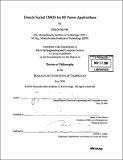| dc.contributor.advisor | Jesús A. del Alamo. | en_US |
| dc.contributor.author | Scholvin, Jörg, 1976- | en_US |
| dc.contributor.other | Massachusetts Institute of Technology. Dept. of Electrical Engineering and Computer Science. | en_US |
| dc.date.accessioned | 2007-07-18T13:07:31Z | |
| dc.date.available | 2007-07-18T13:07:31Z | |
| dc.date.copyright | 2006 | en_US |
| dc.date.issued | 2006 | en_US |
| dc.identifier.uri | http://hdl.handle.net/1721.1/37904 | |
| dc.description | Thesis (Ph. D.)--Massachusetts Institute of Technology, Dept. of Electrical Engineering and Computer Science, 2006. | en_US |
| dc.description | Includes bibliographical references (p. 117-140). | en_US |
| dc.description.abstract | The microelectronics industry is striving to reduce the cost, complexity, and form factor of wireless systems through single-chip integration of analog, RF and digital functions. Driven by the requirements of the digital system components, the 90 nm and 65 nm technology nodes are currently emerging as platforms for highly integrated systems. Achieving such integration while minimizing the cost of adding specialized RF modules places high demands on the base CMOS technology. In this regard, the integration of the power amplifier (PA) function becomes an increasing challenge as technology geometries and supply voltages scale down. Gate length (Lg) scaling yields improved frequency response, promising higher power-added efficiency (PAE), a key RF PA consideration. This benefit comes at the cost of a lower drain voltage, which demands a higher output current and thus wider devices in order to produce a given output power level (Po,,). In this work, we have investigated the potential of deeply scaled CMOS for RF power applications, from 0.25 um down to 65 nm. We demonstrate the frequency and power limitations that the different CMOS technologies face, and describe the physical mechanisms that give rise to these limitations. | en_US |
| dc.description.abstract | (cont.) We find that layout considerations, such as splitting a single large device into many smaller parallel devices, become increasingly important as the technology scales down the roadmap, both for power and frequency. We also show that parasitic resistances associated with the back-end wiring are responsible for placing an upper limit on the RF power that can be obtained for a single bond pad. We demonstrate a power density of 31 mW/mm for the 65 nm node, with PAE in excess of 60% at 4 GHz and 1 V. Similar results are obtained in 90 nm, where a peak PAE of 66% was measured at 2.2 GHz and 1 V, with a power density of 24 mW/mm. We find that efficient integrated PA functionality for many applications can be achieved even in a deeply-scaled logic CMOS technology. For low power levels (below 50 mW), we find that the 65 nm CMOS devices offer excellent efficiency (>50%) over a broad frequency range (2-8 GHz). Their RF power performance approaches that of 90 nm devices both in peak PAE and output power density. This is possible without costly PA-specific add-ons, or the use of higher voltage input-output (I/O) device options. | en_US |
| dc.description.abstract | (cont.) However, since I/O devices are often included as part of the process, they represent a real option for PA integration because they allow for higher power densities. The 0.25 /xm I/O device that is available in the 90 nm process, when biased at Vdd = 2.5 V showed excellent results, with a peak PAE of 60% and an output power of 75 mW (125 mW/mm) at 8 GHz. | en_US |
| dc.description.statementofresponsibility | by Jörg Scholvin. | en_US |
| dc.format.extent | 140 p. | en_US |
| dc.language.iso | eng | en_US |
| dc.publisher | Massachusetts Institute of Technology | en_US |
| dc.rights | M.I.T. theses are protected by copyright. They may be viewed from this source for any purpose, but reproduction or distribution in any format is prohibited without written permission. See provided URL for inquiries about permission. | en_US |
| dc.rights.uri | http://dspace.mit.edu/handle/1721.1/7582 | |
| dc.subject | Electrical Engineering and Computer Science. | en_US |
| dc.title | Deeply scaled CMOS for RF power applications | en_US |
| dc.type | Thesis | en_US |
| dc.description.degree | Ph.D. | en_US |
| dc.contributor.department | Massachusetts Institute of Technology. Department of Electrical Engineering and Computer Science | |
| dc.identifier.oclc | 132802589 | en_US |
